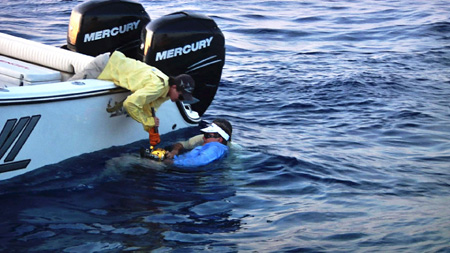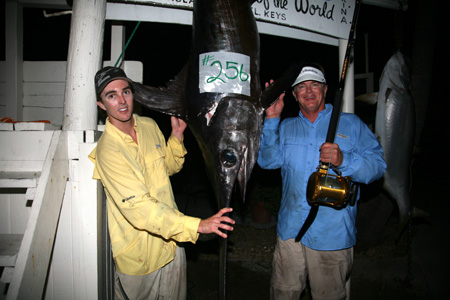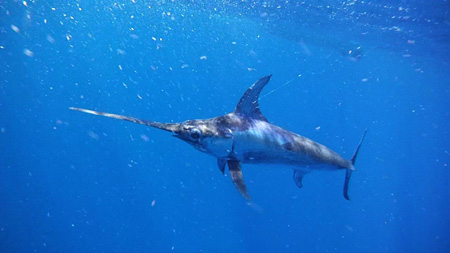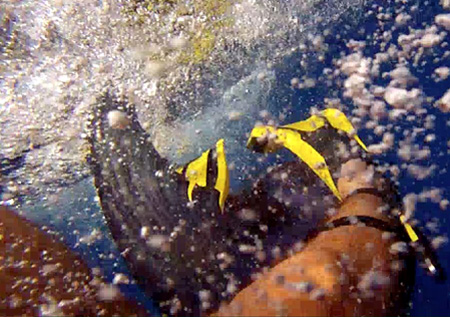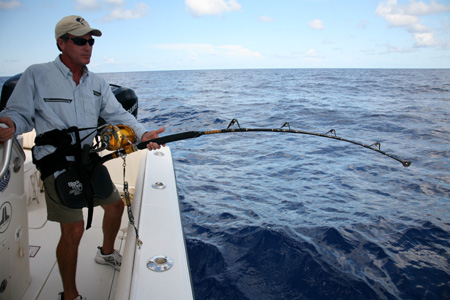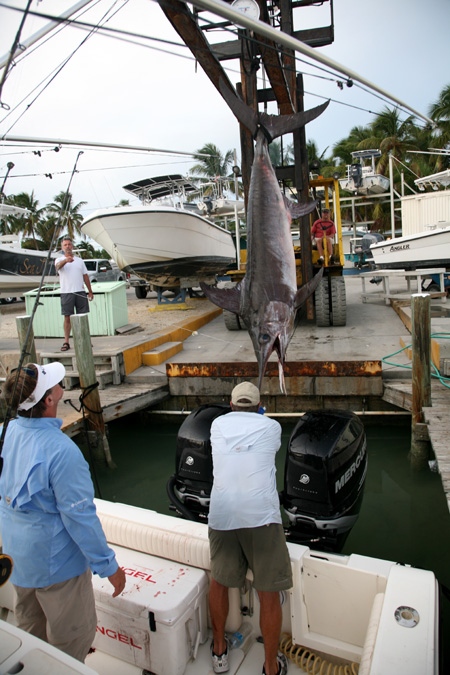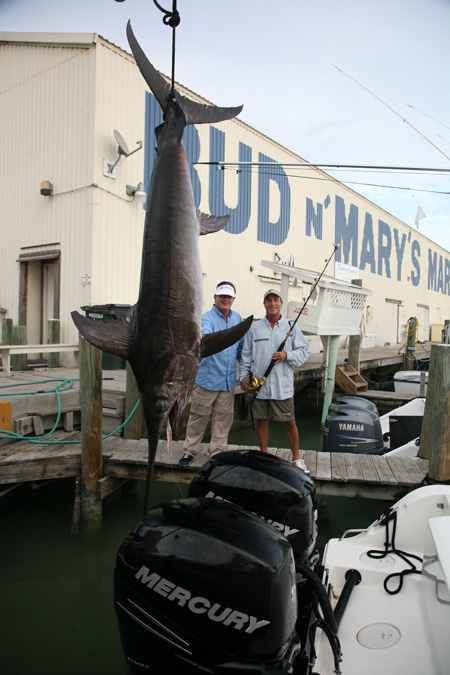
Our swordfish shoot off Islamorada, Florida Keys, in September, 2012, was anything but your typical television production. In fact, looking back, it was the most bizarre and out-of-the-ordinary fishing trip I’ve experienced to date - and two of us came awfully close to dying. There was certainly nothing normal about it.
I had docked the MARC VI at Bud ‘n Mary’s Marina in Islamorada, set to shoot a daytime swordfish episode with Nick Stanczyk. The production team consisted of Kevin Tierney, Rob “Swede” Greene, and pal Carl Grassi, who was gracious enough to haul down his 27 foot center console to use as our camera boat.
On our first morning, we grabbed coffees and muffins at Bob’s Bunz and arrived at Bud ‘n Mary’s at 7:00 a.m. Our start was delayed for over an hour, thanks to a large rain squall offshore. Once it dissipated, we began a 40-plus mile run to the swordfish grounds.
My tackle was a Penn International Two-Speed, 80-Wide, matched to a Penn International six-foot stand-up rod with a short bent butt. The reel was filled with 80-pound test Sufix 832 Super Line (braid), with a 150-foot long, 150-pound test monofilament wind-on leader. Our main leaders were ten feet of 300-pound test fluorocarbon, each attached to a 9/0 hook and rigged to a bonito belly, dolphin belly or squid.
We were set to “day drop” to depths approaching 1,500 feet. To promote the sport in this type of fishing – opposed to those commercially fishing with electric reels - I would donn a harness and rod belt and “hand-crank” a swordfish, stand-up style. I’ve been a proponent of stand-up fishing my entire career, with blue marlin and black marlin approaching 400-pounds, tuna in the lower 200-pound class, and even Mako sharks being some of my most memorable catches via this method. I’ve even caught swordfish, day and night, with stand-up tackle. So, the Islamorada quest wasn’t anything new for me.
There was only one thing Nick Stanczyk and I could do: get back on those numbers and try again. I didn’t say much during the ten-minute ride back to the spot. After all, how many opportunities with a swordfish, let alone a big one, could one expect – especially when shooting a television episode? Ironically, we were about to find out.
STRIKE TWO!
The very next drop, and within two minutes of reaching bottom, the bait gets eaten by another swordfish! I strap up and proceed to fight this one for another hour! Even though I was in another tough, physically-demanding fight, I felt good – confident the odds would favor the hook remaining in this fish.
Nick Stanczyk and I finally caught a glimpse of the sword some 60- to 70-feet away from the boat, and it appeared bigger than the last one! I was now stoked from another rush of adrenaline, knowing we’d soon have an even larger fish for the show! Yet, again, the rod straightened up – another pulled hook. NO! How could this be? Some two hours later of nearly consecutive fighting time, with two quality fish, and we had nothing to show for it, save dejection.
I was livid, knowing we just lost our show with that fish. With swordfish, pulled hooks are common. If you can maintain a 50% success rate, you’re doing well. However, that fact wasn’t comforting at this point. Also bummed, Nick convinced me to go back to the spot and try again.
HIT THREE – GOING, GOING
Amazingly, once the bait hit bottom, it was consumed by yet another swordfish! Again, I quickly donned harness and rod belt and settled in for what would be another physically-taxing stand up fight. This fish also felt big!
Like a scene from the movie Ground Hog Day, here I was, with Nick Stanczyk, going through the same rituals with another big swordfish. This fish was tough, determined to slug it out deep. It dug into the current and stubbornly clung near the thermocline; I’d laboriously pump and wind to claim several feet, only to have this fish run off a hundred plus yards of line. Gains were made in small, grueling strides.
DO THE MATH
Adding the hour long fight with the first swordfish to the one-hour long battle with the second swordfish, and then the two-and-a-half hours invested into fighting our third fish, I had been harnessed up and slugging it out with big swordfish going on four-and-a-half hours! This was beginning not to be fun.
Early in my fishing career, and realizing the dangers associated with offshore fishing – especially with stand-up tackle, I had formulated plans to get myself out of any dire predicaments. This was expedited after having a fighting chair collapse with me in it, strapped to 80-pound class gear and a blue marlin. I persevered, thanks to a spotter who clung on to me, and eventually released the marlin, but the situation could have been ugly.
Aboard my boat, when an angler is harnessed to 50-pound class and heavier stand up tackle, I’ll designate someone to spot them. Should the angler slip, the spotter will prevent them from unceremoniously exiting the boat. And should the angler lean back into a fish - and the hook pulls, the spotter will prevent the angler from falling backwards into the cockpit and possibly striking their head on the rocket launcher, bait well or cooler. A safety line from the reel to the boat, or from the back of the harness to the boat, takes the place of the spotter when it’s just me and another person aboard; if the angler goes over and panics, they can be pulled to safety via the line.
For years, I have rehashed my “escape” routine over-and-over- and-over. Should I ever find myself in the drink, I would be mentally prepared to: 1.) Slowly back off the reel drag; panicking and not doing so, or quickly free spooling and creating a backlash, will enable the fish to pull you down; 2.) Pull the rod to my chest and, once the drag pressure is relieved, unclip and swim out of the harness; and 3.) If step one or two isn’t working - cut the line.
WET AND WILD
Nick Stanczyk and I had just exceeded the two-and-a-half hour mark in battling this swordfish, and it wasn’t showing signs of conceding. I was thoroughly soaked with perspiration, my light blue shirt now a dark blue because of it. I had been drinking bottles of water throughout the fight, to keep hydrated.
The fish was finally coming somewhat closer to the boat, albeit painstakingly. It seemed to be about 200- to 300-feet away, and I was knees-to-the-coaming-bolster in the aft portside cockpit of my MARC VI. I’m pumping and winding, struggling for a few feet here and there. Suddenly, I see Carl’s boat coming around my outboards and in the direction of the fish – and my line!
I panicked, and shouted for Carl to back away. He explained that the camera team wanted footage of our front sides. I reasoned that my fish was out in that direction and I didn’t want to risk his boat cutting the line. I then directed him to back up and go around my boat and come in from the bow; the fish wasn’t in that zone and the low-hanging afternoon sun would be directly behind them. Carl obliged.
I kept at my fish, aware of Carl slowly motoring around the starboard side of my boat. I caught a glimpse of Carl approaching my bow, about the time I leaned forward to take a turn or two on the reel and gain some more line. At that point, the freak accident occurred; as I was leaning forward to take a crank on the fish, Carl’s boat wake lapped against the MARC VI. As gentle as it was, it generated just enough of a snap to throw me off balance; I looked down and my feet were not affixed to the deck – I was going overboard!
However, I then found myself struggling to locate the rod; I needed to pull it to my chest so I could unhook one harness clip and swim out of it. Confused, I reached for and got a firm grip on the gunwale of my boat. The weight of the standup outfit and my totally drenched clothes were working against me; I could only manage to keep my chin and face above water – even with the grip on my boat.
Nick Stanczyk looked like he saw a ghost– his eyes appeared as large as basketballs, and he was clinging to my shirt. Though he was trying his best to aid me, Nick is all of 150-pounds. If anything, I could have taken him overboard with me.
Fortunately, I did not have to make the attempt, as show producer Kevin Tierney jumped from the camera boat and swam to my rescue. And, yes, Rob “Swede” Greene kept his camera rolling! With Nick Stanczyk in the boat, and Kevin alongside of me, they discovered what had happened: On my way overboard, my rod got pulled down between my legs, and the reel turned nearly backwards against my stomach. Kevin managed to get his hands between the reel and my body and unhook one harness clip. That’s all I needed to exit from the outfit. I was now out of danger.
I passed the rod up to Nick, asking him to advance the drag and see if the fish was still there; it was! I attempted to crawl up into my boat, but my rod belt got stuck on the transom. “What next?”, I thought. I undid my belt, tossed it into the boat, and rolled up onto the transom. I took a minute or two to regain my composure, followed by a quick watering of the alligator (I was too scared to pee in the water!). I then got back into the harness and rod belt and proceeded to fight this fish.
The sun was now setting, and we were 40-miles out from Bud ‘n Mary’s. Now, we had to get this fish into the boat. There was just one slight problem: I was shot, and my arms were like jelly. I couldn’t give enough of myself to help Nick haul the fish over the gunwale. So, we eventually succeeded in sliding it through the transom door of my boat. It was time to run home – in the dark! I turned on the navigation lights and headed for the barn.
I was fatigued and still perspiring – even after going overboard. I elected to drive the boat standing alongside the console, letting the cruising air cool me down. I was whipped, but happy. I sipped on an ice cold Budweiser, to not only celebrate the catch, but to help get some carbs back into me while simultaneously numbing some of my sore muscles! I can still see Nick on that dark run back home, frequently spraying down the big swordfish in my cockpit with the raw water wash down hose, and trying to keep ice on it.
VICTORY LANE AND MIDNIGHT CHEESEBURGERS
It was almost 10:00 p.m. when we pulled into a dark Bud ‘n Mary’s marina and backed in by the weigh scale. This was such a surreal feeling for me; Nick’s father and Florida Keys daytime swordfishing pioneer, Richard Stanczyk, was there to greet us. Then came the flashes from still shot cameras and lights from video cameras, as Nick and I offloaded my fish, with help of Carl Grassi. On the scale, it weighed in at 256-pounds!
We then docked the MARC VI. Nick Stanczyk and Carl Grassi cleaned the swordfish, while I washed the tackle and, of course, my boat. Kevin and Rob headed back to the hotel, as it was approaching 11:00 p.m. Nick eventually left, leaving Carl and me to finish up. Talk about swordfish steaks! We had plenty to go around.
More than half-starved, Carl and I struggled to find a place still open for dinner at 11:30 p.m. The Whistle Stop bar was it. We bellied up to the bar, ordered a couple cold and well-deserved beers, and two cheeseburger plates. After a few swigs of brew, and some down time to catch our breath, Carl confided that he thought he was “going to lose his friend today”, when he saw me overboard. We relived that crazy and wild day, sharing our perspectives.
The safety tweaks I learned after my swim? 1.) Always use a safety line when harnessed to stand-up gear – even with a spotter (I had them aboard the MARC VI, but opted not to use them in the shoot – and it nearly cost me my life), and 2.) Wear a cutting tool around your neck or affix one to your rod belt, one which will sever braid.
KEVIN’S NUMBER ALMOST COMES UP
With a big swordfish in the can for our show, we agreed to head out the next day to catch some blackfin tuna on the 409 Hump and dolphin to fill out the episode. We did exactly that, but would soon discover we didn’t need dolphin or tuna to pad this show. Rob “Swede” Greene came aboard the MARC VI to shoot tight footage of our swordfish rigs and us lowering them to the bottom. Nick reasoned: “Why not do this at the swordfish grounds? We might catch one.” I agreed, and we got back on the numbers.
Once the bait reached bottom and Rob said he acquired his footage, we hook yet another swordfish! I go to work and bring up a fish of around 175-pounds, in about 45-minutes. Rob captured amazing footage of the sword. Now, we have two swordfish for our show! Before we release this fish, Kevin Tierney decides he wants underwater footage of it.
Kevin Tierney is highly experienced at shooting fishing television shows, and he knows his species very well; he’s an angler himself and scuba diver. I still warned him that he’s dealing with a broadbill swordfish, and not a marlin or sailfish. These fish are intelligent, mean and highly aggressive; they know where a problem stems from. Kevin nodded and dove off the camera boat, video cam in hand.
I played the fish alongside our boat once more. Again, it sees Kevin, who is now even farther away from us, and charges after him. This time, we were all certain Kevin would die. A totally helpless feeling swept our boat and the only thing we could do was scream and shout at Kevin – who already saw the fish coming at him. I couldn’t turn or slow the fish. This time, the fish didn’t turn. We saw Kevin bounce at the surface. Then, the fish sounded. This couldn’t be good. Shouting inquiries on his well-being, and fearing the worst, Kevin quipped: “He doesn’t like me!” Relieved Kevin appeared OK, I again told him to get out of the water – immediately!
THE ENCORE PERFORMANCE -
With an awesome show in the can, Kevin and Rob headed for home that evening. Carl and I opted to stay and fish together the next day, in return for his helping out with camera boat duties. Nick had a charter booked the next day as well, but we bummed a few swordfish baits from him.
Carl’s sword was now at the surface, but there was something odd; for what we believed to be a small fish, there was a lot of space between the tip of its dorsal fin and tail. Then, the fish realized it was in trouble; it took off on a hard, fast run, and launched every bit of ten feet into the air! Carl and I were in awe of its size, and speechless! It was a monster. The fish leapt completely out of the water three more times, and then sounded. One jump was so close to the boat, it was downright scary.
Shy of the seven hour mark, the swordfish launched into the air yet again – for its 10th time, and sounded. It appeared just as strong as when we initially hooked it! In a stalemate, and not able to gain line, I told Carl I was going to move slowly ahead in an attempt to plane up the fish. It worked for a little, and then the fish sounded; Carl couldn’t budge it. I told Carl to hang on, as I was now going to attempt to “corkscrew” it up, by making circles around it, while Carl maintained pressure and gained line when he could. This didn’t work, as it only aggravated the fish and made it sound even deeper at a more feverish clip.
VICTORY AT SEA!
About 15 minutes after the “corkscrew” maneuver, Carl mentioned that something had changed; he believed the fish had died. He insisted something felt different. We again tried to plane up the fish, eventually finding an angle where Carl gained inches at a time. We kept at it. A good bit later, the line was angling toward the surface. Roughly some 300 feet away, the swordfish pops up – it had gotten tail-wrapped and died!
As mentioned earlier, this was a bizarre trip that knew no timelines nor normalcy. Two of us came close to perishing, and Carl Grassi later admitted he was worried while fighting his big swordfish. I inquired why, and he explained that bad things often happen in threes, and he feared he might have been next up at bat.
Ironically, while washing my boat back at its storage facility in Northern Broward County, I noticed there was not a single bill mark or scratch on it, or the name. I would have thought the opposite, after battling three huge swordfish!
I guess our horseshoe was upright after all, on that bizarre fishing trip to Islamorada, in the fabulous Florida Keys.




